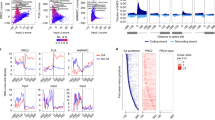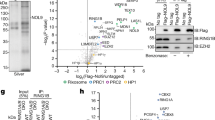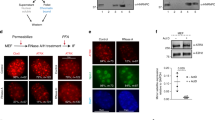Abstract
Several lines of evidence point to a role for noncoding RNA in transcriptional repression by Polycomb group (PcG) proteins, but the precise mechanism remains unclear. Here we show that human MOV10, a putative RNA helicase previously implicated in post-transcriptional gene silencing, co-purifies and interacts with components of Polycomb-repressive complex 1 (PRC1) from human cells. Endogenous human MOV10 is mostly nuclear, and a proportion associates with chromatin in an RNA-dependent manner. Small hairpin RNA (shRNA)-mediated knockdown of MOV10 in human fibroblasts leads to the upregulation of the INK4a tumor suppressor, a known target of PcG-mediated repression, accompanied by the dissociation of PRC1 proteins from the locus and a reduction in trimethylation of histone H3 on Lys27 (H3K27me3). As well as prompting reassessment of MOV10's role in other settings, our findings suggest that it is directly involved in transcriptional silencing by PcG complexes.
This is a preview of subscription content, access via your institution
Access options
Subscribe to this journal
Receive 12 print issues and online access
$189.00 per year
only $15.75 per issue
Buy this article
- Purchase on Springer Link
- Instant access to full article PDF
Prices may be subject to local taxes which are calculated during checkout






Similar content being viewed by others
References
Ringrose, L. & Paro, R. Epigenetic regulation of cellular memory by the Polycomb and Trithorax group proteins. Annu. Rev. Genet. 38, 413–443 (2004).
Schwartz, Y.B. & Pirrotta, V. Polycomb silencing mechanisms and the management of genomic programmes. Nat. Rev. Genet. 8, 9–22 (2007).
Sparmann, A. & van Lohuizen, M. Polycomb silencers control cell fate, development and cancer. Nat. Rev. Cancer 6, 846–856 (2006).
Whitcomb, S.J., Basu, A., Allis, C.D. & Bernstein, E. Polycomb group proteins: an evolutionary perspective. Trends Genet. 23, 494–502 (2007).
Gil, J. & Peters, G. Regulation of the INK4b-ARF-INK4a tumour suppressor locus: all for one or one for all. Nat. Rev. Mol. Cell Biol. 7, 667–677 (2006).
Maertens, G.N. et al. Several distinct polycomb complexes regulate and co-localize on the INK4a tumor suppressor locus. PLoS One 4, e6380 (2009).
Ringrose, L. & Paro, R. Polycomb/Trithorax response elements and epigenetic memory of cell identity. Development 134, 223–232 (2007).
Sing, A. et al. A vertebrate polycomb response element governs segmentation of the posterior hindbrain. Cell 138, 885–897 (2009).
Mercer, T.R., Dinger, M.E. & Mattick, J.S. Long non-coding RNAs: insights into functions. Nat. Rev. Genet. 10, 155–159 (2009).
Wilusz, J.E., Sunwoo, H. & Spector, D.L. Long noncoding RNAs: functional surprises from the RNA world. Genes Dev. 23, 1494–1504 (2009).
Zhao, J., Sun, B.K., Erwin, J.A., Song, J.J. & Lee, J.T. Polycomb proteins targeted by a short repeat RNA to the mouse X chromosome. Science 322, 750–756 (2008).
Pandey, R.R. et al. Kcnq1ot1 antisense noncoding RNA mediates lineage-specific transcriptional silencing through chromatin-level regulation. Mol. Cell 32, 232–246 (2008).
Rinn, J.L. et al. Functional demarcation of active and silent chromatin domains in human HOX loci by noncoding RNAs. Cell 129, 1311–1323 (2007).
Khalil, A.M. et al. Many human large intergenic noncoding RNAs associate with chromatin-modifying complexes and affect gene expression. Proc. Natl. Acad. Sci. USA 106, 11667–11672 (2009).
Grimaud, C. et al. RNAi components are required for nuclear clustering of Polycomb group response elements. Cell 124, 957–971 (2006).
Petruk, S. et al. Transcription of bxd noncoding RNAs promoted by trithorax represses Ubx in cis by transcriptional interference. Cell 127, 1209–1221 (2006).
Sanchez-Elsner, T., Gou, D., Kremmer, E. & Sauer, F. Noncoding RNAs of trithorax response elements recruit Drosophila Ash1 to Ultrabithorax. Science 311, 1118–1123 (2006).
Schmitt, S., Prestel, M. & Paro, R. Intergenic transcription through a polycomb group response element counteracts silencing. Genes Dev. 19, 697–708 (2005).
Kim, D.H., Saetrom, P., Snove, O. Jr. & Rossi, J.J. MicroRNA-directed transcriptional gene silencing in mammalian cells. Proc. Natl. Acad. Sci. USA 105, 16230–16235 (2008).
Kim, D.H., Villeneuve, L.M., Morris, K.V. & Rossi, J.J. Argonaute-1 directs siRNA-mediated transcriptional gene silencing in human cells. Nat. Struct. Mol. Biol. 13, 793–797 (2006).
Weinberg, M.S. et al. The antisense strand of small interfering RNAs directs histone methylation and transcriptional gene silencing in human cells. RNA 12, 256–262 (2006).
Bracken, A.P., Dietrich, N., Pasini, D., Hansen, K.H. & Helin, K. Genome-wide mapping of Polycomb target genes unravels their roles in cell fate transitions. Genes Dev. 20, 1123–1136 (2006).
Lee, T.I. et al. Control of developmental regulators by Polycomb in human embryonic stem cells. Cell 125, 301–313 (2006).
Boyer, L.A. et al. Polycomb complexes repress developmental regulators in murine embryonic stem cells. Nature 441, 349–353 (2006).
Tolhuis, B. et al. Genome-wide profiling of PRC1 and PRC2 Polycomb chromatin binding in Drosophila melanogaster. Nat. Genet. 38, 694–699 (2006).
Kim, W.Y. & Sharpless, N.E. The regulation of INK4/ARF in cancer and aging. Cell 127, 265–275 (2006).
Campisi, J. & D'Adda di Fagagna, F. Cellular senescence: when bad things happen to good cells. Nat. Rev. Mol. Cell Biol. 8, 729–740 (2007).
Jacobs, J.J., Kieboom, K., Marino, S., DePinho, R.A. & van Lohuizen, M. The oncogene and Polycomb-group gene bmi-1 regulates cell proliferation and senescence through the ink4a locus. Nature 397, 164–168 (1999).
Brookes, S., Rowe, J., Gutierrez Del Arroyo, A., Bond, J. & Peters, G. Contribution of p16(INK4a) to replicative senescence of human fibroblasts. Exp. Cell Res. 298, 549–559 (2004).
Dietrich, N. et al. Bypass of senescence by the polycomb group protein CBX8 through direct binding to the INK4A-ARF locus. EMBO J. 26, 1637–1648 (2007).
Itahana, K. et al. Control of the replicative life span of human fibroblasts by p16 and the polycomb protein Bmi-1. Mol. Cell. Biol. 23, 389–401 (2003).
Gil, J., Bernard, D., Martinez, D. & Beach, D. Polycomb CBX7 has a unifying role in cellular lifespan. Nat. Cell Biol. 6, 67–72 (2004).
Mooslehner, K., Muller, U., Karls, U., Hamann, L. & Harbers, K. Structure and expression of a gene encoding a putative GTP-binding protein identified by provirus integration in a transgenic mouse strain. Mol. Cell. Biol. 11, 886–893 (1991).
Cook, H.A., Koppetsch, B.S., Wu, J. & Theurkauf, W.E. The Drosophila SDE3 homolog armitage is required for oskar mRNA silencing and embryonic axis specification. Cell 116, 817–829 (2004).
Dalmay, T., Horsefield, R., Braunstein, T.H. & Baulcombe, D.C. SDE3 encodes an RNA helicase required for post-transcriptional gene silencing in Arabidopsis. EMBO J. 20, 2069–2078 (2001).
Tomari, Y. et al. RISC assembly defects in the Drosophila RNAi mutant armitage. Cell 116, 831–841 (2004).
Chendrimada, T.P. et al. MicroRNA silencing through RISC recruitment of eIF6. Nature 447, 823–828 (2007).
Meister, G. et al. Identification of novel argonaute-associated proteins. Curr. Biol. 15, 2149–2155 (2005).
Wulczyn, F.G. et al. Post-transcriptional regulation of the let-7 microRNA during neural cell specification. FASEB J. 21, 415–426 (2007).
Rigaut, G. et al. A generic protein purification method for protein complex characterization and proteome exploration. Nat. Biotechnol. 17, 1030–1032 (1999).
Sanchez, C. et al. Proteomics analysis of Ring1B/Rnf2 interactors identifies a novel complex with the Fbxl10/Jhdm1B histone demethylase and the Bcl6 interacting corepressor. Mol. Cell. Proteomics 6, 820–834 (2007).
Trinkle-Mulcahy, L. et al. Identifying specific protein interaction partners using quantitative mass spectrometry and bead proteomes. J. Cell Biol. 183, 223–239 (2008).
Hock, J. et al. Proteomic and functional analysis of Argonaute-containing mRNA-protein complexes in human cells. EMBO Rep. 8, 1052–1060 (2007).
Bernstein, E. et al. Mouse polycomb proteins bind differentially to methylated histone H3 and RNA and are enriched in facultative heterochromatin. Mol. Cell. Biol. 26, 2560–2569 (2006).
Yisraeli, J.K. VICKZ proteins: a multi-talented family of regulatory RNA-binding proteins. Biol. Cell 97, 87–96 (2005).
Haussecker, D. et al. Capped small RNAs and MOV10 in human hepatitis δ virus replication. Nat. Struct. Mol. Biol. 15, 714–721 (2008).
Wysocka, J., Reilly, P.T. & Herr, W. Loss of HCF-1-chromatin association precedes temperature-induced growth arrest of tsBN67 cells. Mol. Cell. Biol. 21, 3820–3829 (2001).
Brookes, S. et al. INK4a-deficient human diploid fibroblasts are resistant to RAS-induced senescence. EMBO J. 21, 2936–2945 (2002).
Bracken, A.P. et al. The Polycomb group proteins bind throughout the INK4A-ARF locus and are disassociated in senescent cells. Genes Dev. 21, 525–530 (2007).
Klattenhoff, C. et al. Drosophila rasiRNA pathway mutations disrupt embryonic axis specification through activation of an ATR/Chk2 DNA damage response. Dev. Cell 12, 45–55 (2007).
Josse, T. et al. Telomeric trans-silencing: an epigenetic repression combining RNA silencing and heterochromatin formation. PLoS Genet. 3, 1633–1643 (2007).
Nakano, M. et al. MOV10 as a novel telomerase-associated protein. Biochem. Biophys. Res. Commun. 388, 328–332 (2009).
Schmid, M. et al. A methylthioadenosine phosphorylase (MTAP) fusion transcript identifies a new gene on chromosome 9p21 that is frequently deleted in cancer. Oncogene 19, 5747–5754 (2000).
Pasmant, E. et al. Characterization of a germ-line deletion, including the entire INK4/ARF locus, in a melanoma-neural system tumor family: identification of ANRIL, an antisense noncoding RNA whose expression coclusters with ARF. Cancer Res. 67, 3963–3969 (2007).
Yu, W. et al. Epigenetic silencing of tumour suppressor gene p15 by its antisense RNA. Nature 451, 202–206 (2008).
Agherbi, H. et al. Polycomb mediated epigenetic silencing and replication timing at the INK4a/ARF locus during senescence. PLoS One 4, e5622 (2009).
Gonzalez, S., Pisano, D.G. & Serrano, M. Mechanistic principles of chromatin remodeling guided by siRNAs and miRNAs. Cell Cycle 7, 2601–2608 (2008).
del Arroyo, A.G. et al. E2F-dependent induction of p14ARF during cell cycle re-entry in human T cells. Cell Cycle 6, 2697–2705 (2007).
Acknowledgements
We are indebted to M. Rodriguez-Niedenführ and J. Rowe for substantial contributions to the project and to other members of the Molecular Oncology laboratory for helpful discussions, H. Koseki (RIKEN Research Center for Allergy and Immunology) and J. Gil (Medical Research Council Clinical Sciences Centre) for the generous gift of reagents, N. O'Reilly for help with peptide synthesis and antibody production, N. Totty for MS, C. Esnault for advice on ChIP and D. Ish-Horowicz for insightful comments on the manuscript.
Author information
Authors and Affiliations
Contributions
S.E.M.-A. performed most of the experiments described in the manuscript and drafted the figures and text; J.N. characterized the mCbx7 complex and, together with E.B., provided the initial evidence for the interaction with MOV10; G.N.M. assisted with the gel-filtration analyses; S.B. performed the immunofluorescence; G.P. directed the project and prepared the manuscript.
Corresponding author
Ethics declarations
Competing interests
The authors declare no competing financial interests.
Supplementary information
Supplementary Text and Figures
Supplementary Figures 1–8 (PDF 917 kb)
Rights and permissions
About this article
Cite this article
Messaoudi-Aubert, S., Nicholls, J., Maertens, G. et al. Role for the MOV10 RNA helicase in Polycomb-mediated repression of the INK4a tumor suppressor. Nat Struct Mol Biol 17, 862–868 (2010). https://doi.org/10.1038/nsmb.1824
Received:
Accepted:
Published:
Issue Date:
DOI: https://doi.org/10.1038/nsmb.1824
This article is cited by
-
PHEVIR: an artificial intelligence algorithm that predicts the molecular role of pathogens in complex human diseases
Scientific Reports (2022)
-
Biological and RNA regulatory function of MOV10 in mammalian germ cells
BMC Biology (2019)
-
MOV10 binding circ-DICER1 regulates the angiogenesis of glioma via miR-103a-3p/miR-382-5p mediated ZIC4 expression change
Journal of Experimental & Clinical Cancer Research (2019)
-
Long non-coding RNAs in ovarian cancer
Journal of Experimental & Clinical Cancer Research (2018)
-
Mov10 suppresses retroelements and regulates neuronal development and function in the developing brain
BMC Biology (2017)



